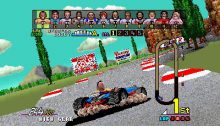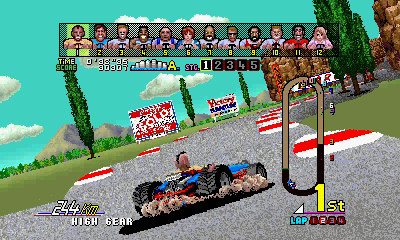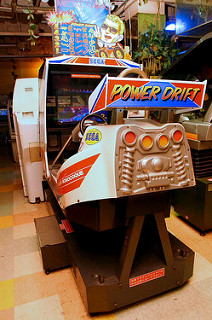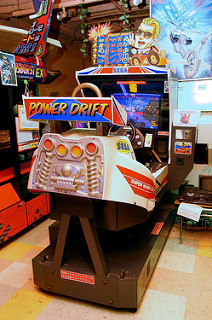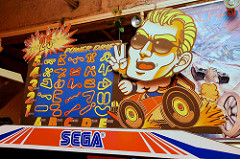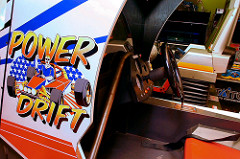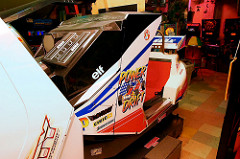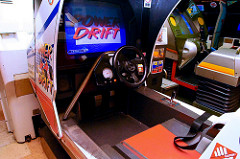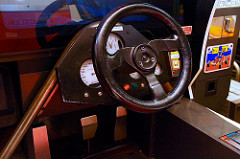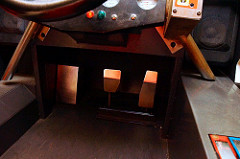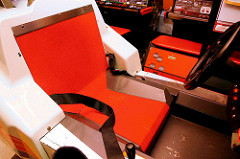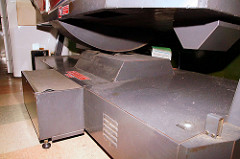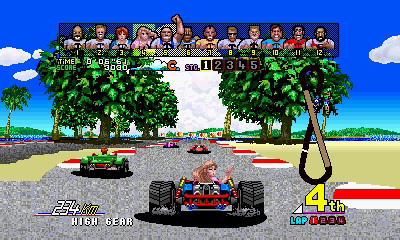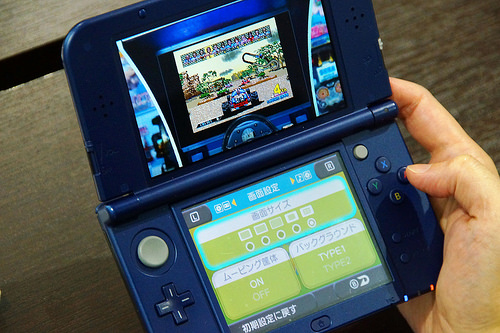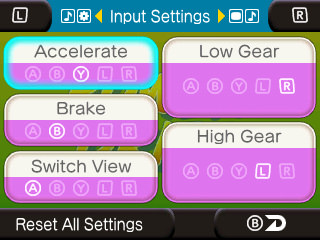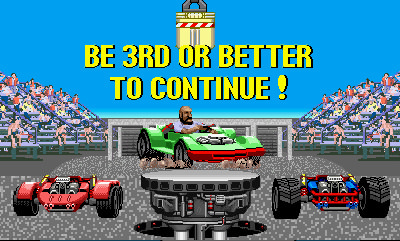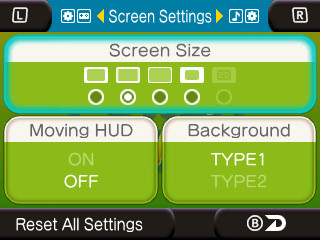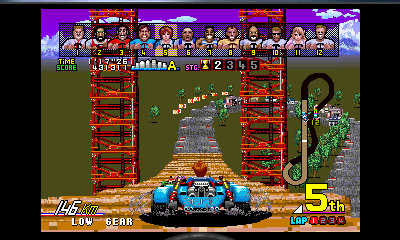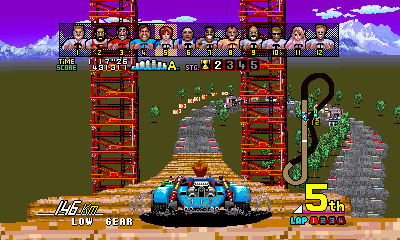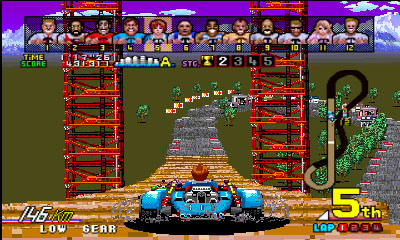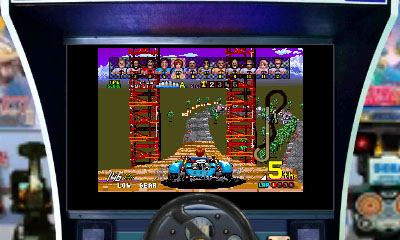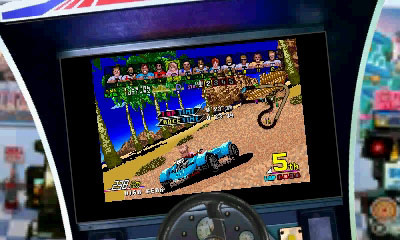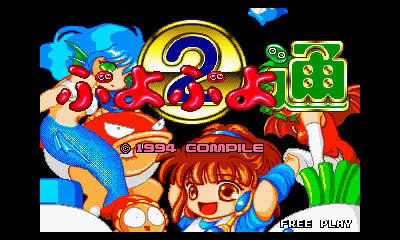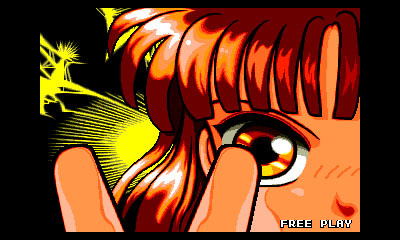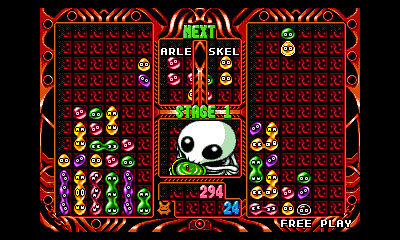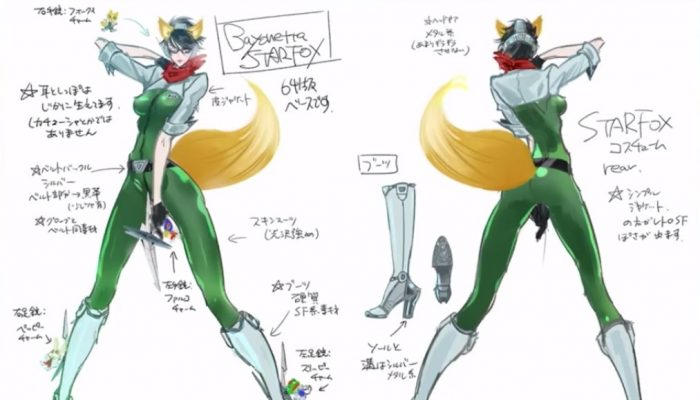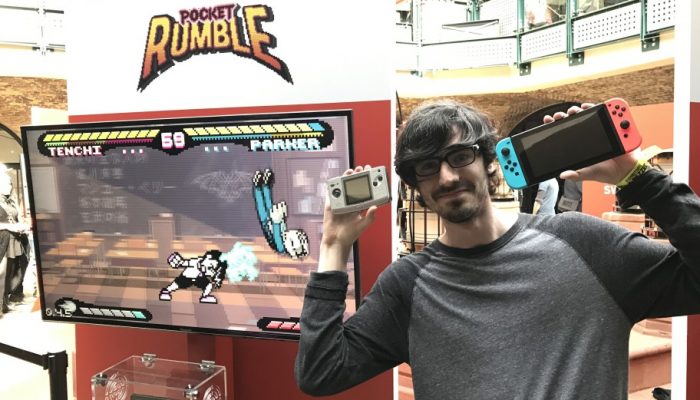 “It might not mean much to the players out there, but having Power Drift running on 3DS is a miracle in itself.”
“It might not mean much to the players out there, but having Power Drift running on 3DS is a miracle in itself.”
☆ NintendObs Weekly – Monday, May 16, 2016 – Sunday, May 22, 2016.
Tuesday May 17, 2016
Power Drift – Yu Suzuki’s Finest 2D Game, Recreated with Detailed Care
Power Drift was released by SEGA into the arcades in 1988. Developed by what would eventually become AM2, the famous Yu Suzuki was involved with its creation. The arcade cabinet’s Deluxe Version seat would move in response to the way you handled it, with a standard style Sit-Down Version and a local multiplayer version being released later, dubbed the Twin-Cab Version.
The game revolves around selecting your driver and starting course and blazing through 5 courses with a total of 12 buggies while trying to place within the top 3. The break-neck up and down of the tracks running at 60 FPS earned the reputation of being a roller-coaster racing game.
In addition to the arcade version, it saw ports for the PC Engine (Turbo Grafx-16) in 1990, the Sega Saturn in 1998, and a Dreamcast version as part of the 2001 Yu Suzuki Gameworks Vol. 1.
We’re back with Part 2 of the interview! You can read the first part here.
So for Power Drift, there was a Twin Cabinet Version that supported network-versus. What did you do with that?
NH: This is a port of the Deluxe Cab, which is the nicest of them, so not the Twin this time. If we added the Twin, we’d have to make it support network play, which is a totally different beast.
YO: Besides, the Twin doesn’t just change the cabinet; it’s a fundamental rework of the game itself.
I don’t know this first hand, but from what I imagine, when Power Drift was released, Final Lap (1987) had started this Twin Cab boom around that time. So they must have thought SEGA should release a twin cabinet too. Power Drift filled that need.
But Power Drift wasn’t originally made to be played against other players. It had limitations like it being too fast or courses not being built for multiplayer. So I believe that was why the Twin Version has slower speed and the crazy courses were cut from the game and made into more normal courses.
That’s what the Twin is, so when we had to pick a version of Power Drift to do, you could imagine our hesitation.
NH: Of course, there are people who like it, and being that these are ‘archive’ projects, we would’ve liked to put both of it in. But if we did that, we would have to re-look at the schedule and use extra energy for that netplay. It would have required more memory too. It’d have been very difficult when you think about it.
The game itself had large differences, and internally it was completely different, so it would have been like a totally new project.
NH: One of the biggest reasons was that from a coding perspective, it was a completely different game. It wasn’t that everything was different, but it was to the point that it wasn’t the same game. We would like to someday port the Twin as well, but it wasn’t possible this time. I mean, like we said, look where we were as of September. (wry smile)
You spoke earlier about the source code. Galaxy Force II was created by the group later known as SEGA AM1, while Power Drift was create by the team later known as SEGA AM2, so it’s one of Yu Suzuki’s titles, correct? Even though it was the same Y-Board, I’d imagine there were differences in how it worked.
NH: Hmm, I wonder. Regardless, we pull the code to pieces, analyze it, and reconstruct it.
YO: Actually, we never provided the source for Power Drift to M2. We handed over the source for Thunder Blade though….
Oh, I remember now! When we made 3D Out Run, we were looking for the source and materials for Out Run and we found the source for Yu Suzuki Game Works* on the Dreamcast. We found Power Drift in there.
NH: Oh that’s right! I think it was the SH-4 version.*
YO: We handed that to Horii-san, and asked if he could use it to port Out Run. I remember him saying, “This may make Power Drift a reality…” (laughs)
He was so enamored by the Power Drift. (laughs)
NH: I do vaguely recall that!
*SH-4: A CPU architecture that was employed in the Sega Dreamcast and NAOMI arcade boards.
*Suzuki Yu Game Works Vol. 1 – Released in 2001. A book that compiled materials of works by game creator Mr. Yu Suzuki, with the extra disk having five “physical experience’ games that Yu Suzuki worked on including Hang-On, Space Harrier, Out Run, After Burner II, Power Drift available to play on the Dreamcast.
YO: The Power Drift from the Yu Suzuki Game Works was different than the other games that appeared in Shenmue. The sound was streamed, and I’m sure who worked on that bit was different from the rest. Out Run most likely was created on the same line as the Sega Saturn version while Power Drift was newly created. While building them, I’m sure there were many changes and tricks done to make it work on the Dreamcast. Those probably became the foundation for the work Saito-san was doing on the project.
NH: He probably got all excited when he realized that they were doing it this way or that way because of the SH-4.
YO: But the source I gave them wasn’t the final version. (laughs)
NH: The source is never the final version. It’s usually the one before the submission master, or one slightly better than that. Looking at the one past the final is really nice. It’s a learning experience as you can see things like, “Oh they regretted that so they went back and fixed it,” or, “Why would they take time to go back and fix THAT?!”
They make it so that if they have the time to, they can switch it out with an even better build.
NH: It does happen.
For Galaxy Force II, you have previously mentioned that the Y-Board had its L/R channels reversed. So for the SEGA AGES 2500 series, you fixed it when you recorded the stream data. Was it the same for the Power Drift’s system board?
NH: It was mostly the same, and I believe the L/R channel was reversed just like Galaxy Force II. However, I believe they used to create the Y-Board along with the cabinets so it may be that the L/R channels were fixed in the latter lots.
YO: Most likely, the arcade development for Galaxy Force and Power Drift were done concurrently.
NH: I actually had a chance to talk with Yu Suzuki a while ago, and we chatted about Power Drift. I commented that it was an amazing time back then. SEGA used to build all the boards themselves and still made money back on them. He replied nonchalantly, “Crazy right? But, I think they were able to make all that back with just one of my games.” He’s so cool. (laughs)
A tremendous amount of sprites at 60 fps, a title worthy of being called one of the best Sega “physical experience” games of the 2D graphics era.
As for the porting process, did you make sure Power Drift worked in its 2D state first before starting to make it 3D? Or did you do that process simultaneously?
NH: I believe we worked on the porting and stereoscopy process simultaneously. For Power Drift, you were able to change the camera-view with the start button, so even though it was really rough, we put in depth with the 3D at a rather early stage. We’ve mentioned before how hard it is to add in widescreen back when we discussed Out Run, After Burner II, and Space Harrier, so naturally we had trouble there.
I see. The Y-Board has z-axis (depth) values for the sprites as well, correct?
NH: The Yu Suzuki Works games do. The z-axis has always been there. So we build off of those for stereoscopic 3D.
YO: Additionally, we have to decide on where’s the center point, where’s the horizon point, those sorts of things. We got a built-up knowledge base for that sort of thing, so we didn’t lose any time figuring that out before dropping in the 3D.
NH: We’ve become pretty used to the 3D stereoscopy process, so we want to tackle new challenges too. Taking an example from Galaxy Force II that we tried and failed, it’s a game where you move forward into the screen, so you know how objects should appear really deep in the screen, right? If we were able to double the limit of how many things we could show, it would look even better. We hope to be able to do that in the future.
I see. One of the huge aspects of stereoscopic 3D is that the way you view it changes, so it sounds like the feel of it would change a lot as well.
By the way, in Power Drift, the cars move up and down, and the sharp turns cause the course and cars to swing hard left and right. I mean, the things being drawn on screen change drastically, right? Did that all work out in the end?
NH: You have to make sure you can make it over the parts where the load is the heaviest, and man, Power Drift has some really heavy parts! There’s no leeway at all! As we said before, it was enough that we considered splitting framerate targets between normal and New 3DS.
What also made the process difficult was mostly the fact that we didn’t have anything to work off of. We didn’t have the original arcade source code, so we would have to pull data out of the ROM, analyze it, rinse, repeat to finally get a basic source image. Sort of what we did for Galaxy Force II too.
You said that since Galaxy Force II had been recreated for the ported to PS2, that helped when building it for 3DS. But you didn’t have [that groundwork] for Power Drift.
NH: Right, we had that for Galaxy Force II. So in that sense, Power Drift was a completely new port for us.
YO: Huh? Didn’t we hand over the source for Galaxy Force II? Though, it was an 8-inch floppy disk so maybe you couldn’t even read it in the first place.
NH: Oh I was readable, but we couldn’t use it in the end. So we had to analyze it by hand. It was quite difficult, actually. (laughs)
Power Drift – The 3D stereoscopy makes the game better! Detailed Painstaking reproduction of how the cabinet handled and the way it sounds!
Playing the Power Drift. Switching into the cabinet mode lets players enjoy how the arcade version felt back then!
OK I’m going to give Power Drift a shot… Wow, the background in cabinet mode has Space Harrier and Thunder Blade. There’re posters for for Galaxy Force II and Fantasy Zone too. So much detail.
YO: The placement for it kept changing up until the final version. It seems like they kept reconsidering things, like the placement for Thunder Blade is a little too this, or a little too that. We would take photos of the screen for PR purposes, but they kept changing it. So we would shake our heads and re-take it, but then it would change again. (laughs)
But it’s the small details that make it fun. Even though it sounds like hard work. By the way, how did you record the environmental sounds this time around?
YO: SEGA doesn’t have the cabinets for ones after Power Drift. So we had to go to the MIKADO game center in Takadanobaba after-hours and record the cabinet noise in the middle of the night. But there were some mistakes and whatnot, so we had to have two recording sessions. Other than the sound, the cabinet at the MIKADO is missing the emblem in the center of the steering wheel so we had to go to the ROBOT arcade center in Fukaya in Saitama to make sure we had it right.
Sounds like you had to travel around a bit. Oh, and I’m seeing four gear types in this version, including an AT setting. What is this?
YO: The arcade didn’t have AT, so that’s a new feature. For the ‘Switch,’ ‘Toggle’ and ‘Hold’ settings, you can use them to make L/R buttons have the same function, or you can make it the same as how the Dreamcast version had it.
Gear Type & Command Settings
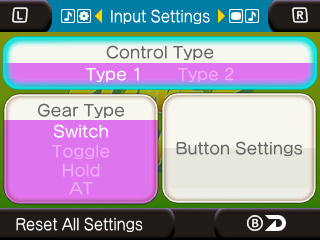
NH: Different people have different play styles based around when to drift or changing gears. You’ll get a variety of gear styles, just like 3D Out Run. You can really feel the attention to detail to make sure the game is easy to play.
YO: There was a lot of attention here. Power Drift hasn’t really seen a proper console port before. There were ones for PC Engine (Turbo Grafx 16), Sega Saturn, and Dreamcast, and the Dreamcast one was mixed in with others in the Yu Suzuki Game Works, as we’ve mentioned. I don’t think there were a lot of people back then who had the chance to really play Power Drift. Those who did probably did it through the arcades.
That’s why the advice Professor Asobin gives when loading the game are things useful to clearing the game.
Kubota-san, who joined M2 mid-project, was a player of the arcade version, so he taught us all these tricks about the game. This game has lots of ways to slow down before turning a corner, so memorizing those tricks is a real good idea.
NH: Kubota played Fantasy Zone quite a lot, but he also played Power Drift quite heavily too. For example, during the debug process when we had to finish all courses in 1st place, Kubota just blew through it. He was a huge help.
How did you go about really getting the sensation of steering right, which is very tactile? Were you able to smoothly apply the steering’s analog input resolution to the 3DS slide pad?
NH: There was enough resolution so we could map it directly. However, if we kept it totally same, there would be a noticeable difference due to the difference in how the controls work. So we would play the cabinet at MIKADO, and try to match that sensation with the 3DS. You know, just try to get it right that way.
At the end of the day though, we owe a lot to some guys who let us borrow an arcade board, to which we connected a Dreamcast steering wheel controller and played that. We would make the final adjustments on the 3DS by comparing it to the way the MIKADO cabinet and Dreamcast steering wheel controller felt.
YO: We really put a lot of thought into how this felt, but we are ultimately waiting on feedback from the players as to whether or not it feels just like the arcade or feels completely different. It’s really quite subjective.
NH: Recreating the feeling of the actual machine was really difficult, but by the time Kubota joined the team, it was basically done. Kubota said he didn’t feel anything wrong with it. We think it’s easier to play than the Dreamcast version.
YO: Incidentally, Power Drift sorts of adjusts our position on the track, which makes it easier to drive, but there’s an option to toggle that on or off.
Since the tactile feel of the game has a direct impact on the gameplay, it’s good to know you’ve adjusted it as needed. So next, I wanted to focus on the 3D itself. This is pretty amazing! Though, there might be some who get sort of nauseous from it…
NH: Well, you are running over a pretty bumpy road, after all.
You really feel the depth of this screen you are driving into. The stereoscopic 3D goes pretty far into the screen. It feels like this might even have the deepest parallax to date.
YO: Power Drift is a rollercoaster game, so there’s parts where you’re driving high up, and then drop really fast. Thanks to the stereoscopic 3D, you really get that feeling of falling.
The stereoscopic 3D really delivers a unique charm here. In the other games, the 3D is applies in a similar fashion, but for this game, you can really see how the sprites make up the course, and it makes it easier to play.
YO: Another way we’ve made it easier to play is that while we’ve ported all same difficulty levels that exist in the arcade versions of Power Drift and Puyo Puyo 2, we’ve also added in a lower difficulty that’s lower than what originally existed.
Power Drift is a hard game. Personally, I think when you first play it, you should play it at the easiest difficulty. The collision detection is much looser. You can learn how it’s supposed to feel.
I get it. I gotta say though, I really feel nothing out of place with the controls, and the 3D really stands out (no put intended). In the original arcade, when you crash, there were just things all over the screen so it was hard to understand what was happening. But seeing it in stereoscopic 3D makes it easy to see the placement and distance between everything.
NH: Well, that’s because it’s a Yu Suzuki game (because z-axis is there from the get-go). It’s all well-thought out. It really is.
It seems you can switch between the Japanese version and overseas version. What are the differences?
YO: The game itself shouldn’t change. There are a lot of Japanese messages in this game, and all this changes is the messages into English.
And is it true that the replay fast forward speed is quicker on the New 3DS than the regular one?
NH: Yes, that’s right.
YO: It’s just a matter of the processor not being able to keep up during fast-forward. You can really see the difference in the specs here.
I see. And you can adjust the BGM and SE controls for arcade games is in as well. You guys started adding that feature in halfway through the SEGA 3D Remaster Project, but it’s basically a tried-and-true standard now. But it’s not actually that easy to put in, is it?
NH: We added interrupt request numbers for all of the sounds, which let us change them. We’ve done this before, so since we know how to do it, we sort of leave it until the end to work it in. But it does start to pile up, and creates a rather exhausting amount of stuff to do.
Screen Size
The four types are: The original 4:3 style; Widescreen style, which fits the 3DS; Full Screen, which just stretches it to fill the screen; and Cabinet View, which puts you in the actual arcade cabinet! And when you turn the Moving HUD on, it enables the “2D” screen mode, which makes it so only the cabinet and background are in 3D.
Is my understanding correct that you didn’t add any additional features or modes outside what was in the original game?
NH: No, we didn’t. Our main focus was getting widescreen and stereoscopic 3D.
YO: As you know, we typically add in new and additional content into games in the 3D Remaster Project, which we affectionately call a “Grantanoff.”* For this project, the Grantanoff wasn’t new content, but just simply MORE content.
For example, we added a whole new stage and a boss for Thunder Blade, so we basically added more game. So in that respect, you could say half of the content itself is a Grantanoff.
Putting in an whole new title is a Grantanoff, so you don’t get a Grantanoff in a Grantanoff. Sorry!
*Grantanoff: In the second wave of the SEGA 3D Classics series, this term is used for ‘ a new feature not found in the original’. It comes from the name of a boss specific to the Mark-III version that they tried to add into 3D After Burner II.
NH: We might have been able to do a ‘Grantanoff within a Grantanoff’ if we only had Power Drift to deal with, but there was just a lot going on this time.It might not mean much to the players out there, but having Power Drift running on 3DS is a miracle in itself. We were even able to recreate the sound so it was a miracle of a miracle. I hope everyone can appreciate and enjoy that.
Puyo Puyo 2 – Porting the arcade version, Okunari-san makes a plea on the fans’ behalf
Puyo Puyo 2 is the second game in a now long standing series, originally developed by Compile and published by SEGA into arcades in 1994.
At the time, competitive fighting games were booming, and Puyo Puyo 2 also puts its multiplayer aspect mainstage, allowing a bold player to interrupt another player’s game and challenge them on the spot. It gained popularity from light users, who enjoy it’s fun puzzle gameplay, to hardcore players, who want to rise to the top through intense competitive play.
On the spec front, it runs on the “C2 Board”, which is based on the Mega Drive / Genesis hardware. The CPU is a MC68000P10, with 2 background layers, and the capability to display 80 sprites on-screen. The Sound IC chip is a YM3438 (OPN2C), a SN76494 (DCSG), and a µPD7759 for the ADPCM sample playback.
This game has been ported many times over the years in many shapes and forms, and has existed on practically every generation of home console hardware, with new stories and characters being added as console-only content. Different consoles would have different features, with original modes like “Endless Puyo” (a mode where you can play by yourself endlessly), “Mission Puyo” (a mode where you clear each mission given to you, similar to a chess problem), and “Multiplayer Puyo” (a mode where you can play against up to 4 people).
Puyo Puyo has also made various appearances outside Japan under different monikers, especially in the early years. Puyo Puyo 2 was release outside Japan on both the Genesis and Game Gear as Dr. Robotnik’s Mean Bean Machine, and the SNES version of the series, Super Puyo Puyo was released outside Japan as Kirby’s Avalanche or Kirby’s Ghost Trap, in NA and EU respectively.
However, a pure port of the original arcade version of Puyo Puyo 2 was first done by M2 in 2011 for the Wii’s Virtual Console arcade version. It was open for online battle mode through the Nintendo Wi-Fi connection, but in May 2014 the Nintendo Wi-Fi connection service ended, which ended the online matching service for this title.
I would like to focus on Puyo Puyo 2 next. It’s my understanding that when you decided to include a puzzle game, Puyo Puyo 2 wasn’t the first choice, correct?
KS: So rewinding a little bit, before we settled on Power Drift, we had a couple of titles to choose from for this. We talked about Alien Syndrome, Golden Axe, Turbo Out Run, and even Columns.
NH: (looks at the lineup list) These are pretty bold choices.
I’d like to see Alien Syndrome someday. Stereoscopic 3D would be really effective in that game.
NH: Oh that game is amazing. We did a little test on it to see how it would turn out and it was great. Although, doing every single stage would be quite an effort.
During TGS, you talked about when Columns was brought up, Okunari-san suggested Puyo Puyo 2 would be better.
YO: Once we settled on Power Drift being sort of the main addition to the lineup, I felt I needed to stir the pot a bit more. You could say it was enough with just Power Drift, but I really wanted more games in the collection compared to the one we had done before.
So I was thinking about having them add more games, and I remembered in a previous interview Horii-san saying he wanted to do a puzzle game and it’d be easy to do on 3DS.
NH: Let’s make that “it’d seem easy to do.”
YO: (laughs) The idea was to port a puzzle game, which is relatively easier to do, so that we can add more game titles, but also not take a lot of time doing it. And since it’s all in a single package, we have to think about the mix-and-match of genres so they don’t overlap. A puzzle game we hadn’t previously selected as part of the SEGA 3D Classics on the Nintendo eShop, something that would be easy to add 3D too…
So with that, I turned to Shimomura and asked, “How about a puzzle game?” So then M2 replies with, “We can do the Mega Drive version of Columns,” to which I said, “What!? That game AGAIN!?”
NH: Well, we suggested exactly because it was “again!” As it turns out, we’d just finished porting it as part of the VITA companion app that accompanied the Japanese version of Yakuza 0, so we’d already had it analyzed. So it wouldn’t have taken much time to get it onto 3DS. But Okunari-san said, “From a consumer perspective, we just released that game.”
YO: As a customer, even though there are differences between PS Vita and 3DS, if we put in the same game that M2 had just released within the same year, we wouldn’t really be able to use that a selling point, right? So from there, we thought, “OK OK, what’s a puzzle title that SEGA owns that is going to make the most fans happy.” Well, the only answer is Puyo Puyo 2. Not the first one, either.
So I say this to M2, and they replied, “Okay, we’ll port the Mega Drive version of Puyo Puyo 2.” Man, I was like, “What are you guys thinking!?”
*The Genesis version is known as Dr. Robotnik’s Mean Bean Machine outside Japan.
M2 had previously ported the arcade version of Puyo Puyo 2 for the Wii Virtual Console. The reason we did it was because we had remembered Puyo Puyo fans saying to Hosoyamada-san, “The Mega Drive version and the arcade version aren’t the same! There’s just something special about that arcade version! That’s what we want!” But even after saying that, they were pretty bent on doing the Mega Drive version.
The Mega Drive version Puyo Puyo 2 runs on Mega Drive, while the arcade version runs on the C2 board, which they say is close to the Mega Drive hardware.
If you can build the Giga Drive, surely you can make a stereoscopic 3D enabled version of the C2 Board, right!?
And that’s what I told Shimomura to tell M2. (laughs)
*Mizuki Hosoyamada: Overall producer for Puyo Puyo series at SEGA.
NH: Wow, the suggestions going on behind the scenes here are just too much!
KS: If I wanted the fans to feel how magnificent the games were, I figured I had to ask. So I said, “Dear sirs, might I ask if this is possible?”
YO: Originally, I told Shimomura, “If we are going to go as far as to add the Mega Drive version of Columns, wouldn’t it be better to put the arcade versions of Puyo Puyo, Puyo Puyo 2, and Columns and Columns 2?”
NH: That’s crazy! This man spouts madness!
YO: But then I figured, “OK, maybe that’s a little bit of puzzle game overkill. (laughs) So let’s just choose one.” But M2 had replied saying Mega Drive Puyo Puyo 2. So I felt that we weren’t on the same page.
NH: What? We were on the same page!
Well, it doesn’t sound to me like you were on the same page. He wants to do the arcade version. (laughs)
NH: What I mean is that even though we look like we always do what we want, we select games while keeping that schedule in mind. I know it doesn’t look like it.
But we really do!
Do you now? (laughs)
NH: We do! I’m serious!
If we’re doing Power Drift, we have to keep the load light for other games or else we would run out of breath before crossing the goal. That’s what I meant. You guys are turning my words against me!
YO: Well, I had heard that Saito-san was in charge of Power Drift, so I figured there was another open development line.
NH: An open line he says! Ha… Hahahaha!
(Horii-san starts laughing.)
KS: Well, you know. If you don’t shoot for just above your capacity, you know? You won’t get anything interesting!
NH: …Oh, I know what you mean!
Well, I suppose that’s how producers are supposed to be tugging on the leash, handling the team, as it were. (wry laugh)
NH: Investors always say the most unreasonable things!
Although you’ve done it on a different console, would you consider adding on a new arcade title on top of Power Drift, something that is a little or a lot above capacity? (laughs)
NH: I was so sure we wouldn’t be able to hit the schedule this time. When we were building out the team for this Collection, and discussing with the director Matsuoka, he stated, “This is impossible! I’ll have no part of this!” We had to really negotiate with him to get him to stay on board.
YO: This whole lineup thing was before we had the date and budget set though.
NH: But you still told us to finish it before the end of the year.
YO: That I did. (smiles)
You could kind of guess where they were aiming for the release date though.
YO: I’m just asking this from the position of a fan now though. (laughs)
NH: Even Matsuoka said that even if we got really expert programmers to help, it would have helped but we still wouldn’t have gotten it done in time.
To tell the truth, the Mark III Fantasy Zone was almost not included because of the whole FM Sound Unit thing, but thanks to the newcomer Kasuga, we managed to get it done.
So you barely got it done, but were saved by this unexpected new employee. (laughs)
NH: We brought on a new guy who wasn’t working on sound, this guy Kubota. He’s also a huge SEGA fan, and when he saw the development for the Power Drift on the 3DS he quietly said “Oh… my… gosh… It’s running…” From a fan perspective, Power Drift looks like it shouldn’t actually run on 3DS.
You’re right, it’s really hard. On the SEGA side, were you guys really confident Puyo Puyo 2 and Power Drift would really run, be finished on time, and everything would be okay? Or… were you nervous?
KS: We were nervous. (laughs)
(everyone laughs)
KS: During the company meeting, I was asked “Is this project going okay?” to which I would answer, “Oh yeah, it’s going fine,” while internally thinking, “If I were Pinnocchio, I’d have poked this guy’s eye out with my nose right now.”
Even though I was saying it’d be done on time, what I meant is that I’d get it done on time. So I would turn to M2 and say, “I’ve put my neck out for you and said it’s going to be fine, so I’m leaving this in your hands.”
NH: The typical I’m-leaving-this-in-you-hands shtick.
You’re pressure style is a bit different than Okunari-san’s. …Just listening to all this makes my stomach knot up. (laughs)
A comment from the director, Tsuyoshi Matsuoka
M2 Director Tsuyoshi Matsuoka: Director and central figure in the SEGA 3D Classics Series. He is a craftsman who is very particular in his work.
I heard during the start of the development for this game, when you heard the lineup for the game titles you objected by saying, “This is impossible! I’ll have no part of this!” Could you tell us how you felt back then and any difficulties you had during development?
Tsuyoshi Matsuoka: I have a clear recollection of the time, but saying, “Impossible! I’m stepping down” feels like the moment I step out the door a monster would attack me.
That aside, I never thought this project would actually move forward. We are talking about nine titles here, and I had no idea why they would put Fantasy Zone in there. And adding in FM Sound? Geez, I had no idea.
— ejrivera at SEGA
Source: SEGA Blog.
At NintendObserver, the comments are on Discord.
Click on Community to learn more. 🙂
…
…Wanna play? Buy a 3DS.
And if you’ve already got yours, click on SEGA 3D Classics Collection for everything you need to know about the game. 😀
